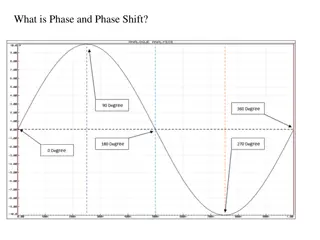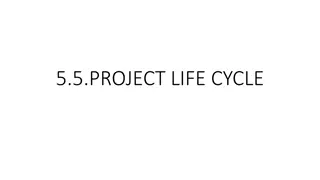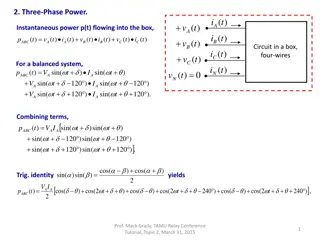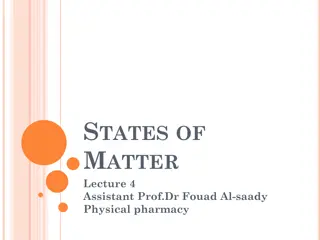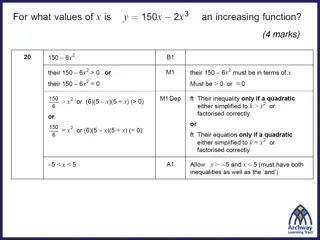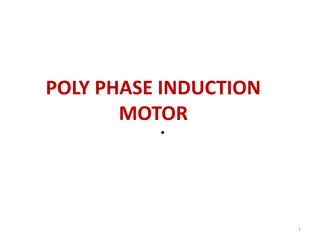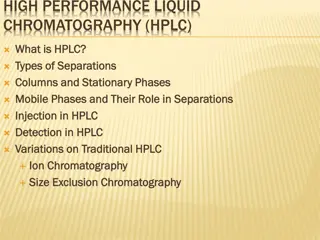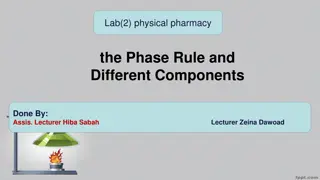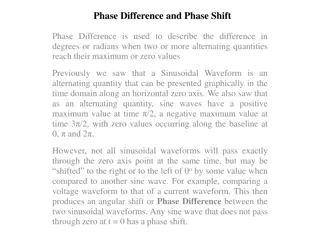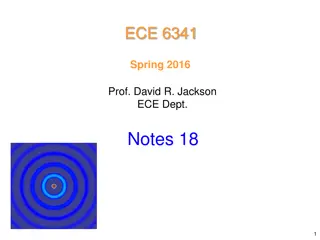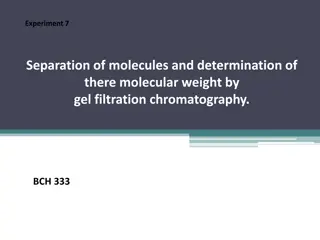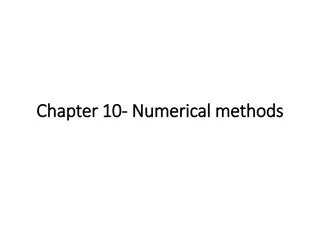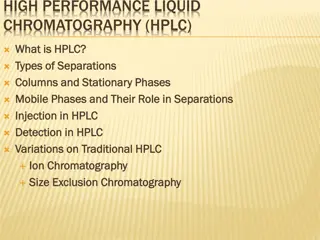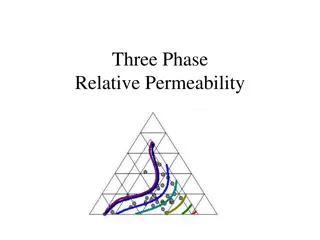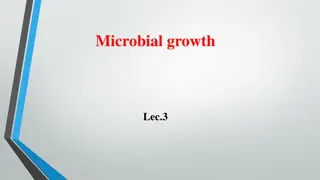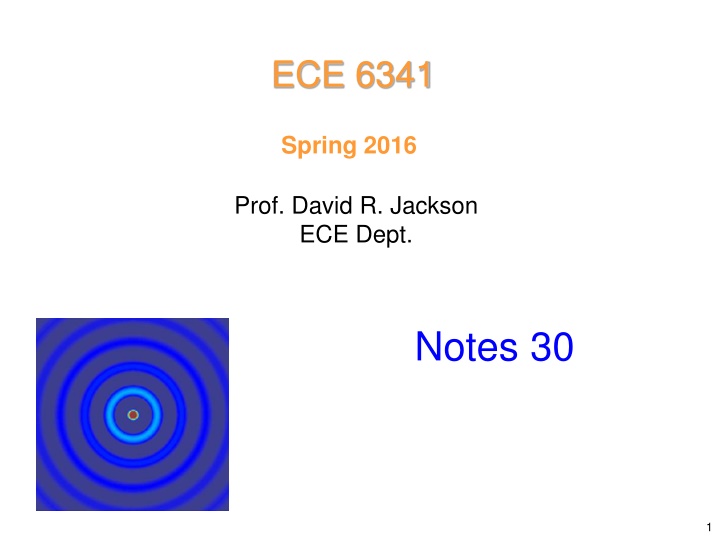
2-D Stationary Phase Method in ECE 6341 with Prof. David R. Jackson's Notes
Explore the 2-D Stationary Phase Method concept explained in ECE 6341 class notes from Prof. David R. Jackson's Spring 2016 session. Dive into the theoretical framework, assumptions, and mathematical derivations involved in this advanced topic in Electrical and Computer Engineering.
Download Presentation

Please find below an Image/Link to download the presentation.
The content on the website is provided AS IS for your information and personal use only. It may not be sold, licensed, or shared on other websites without obtaining consent from the author. If you encounter any issues during the download, it is possible that the publisher has removed the file from their server.
You are allowed to download the files provided on this website for personal or commercial use, subject to the condition that they are used lawfully. All files are the property of their respective owners.
The content on the website is provided AS IS for your information and personal use only. It may not be sold, licensed, or shared on other websites without obtaining consent from the author.
E N D
Presentation Transcript
ECE 6341 Spring 2016 Prof. David R. Jackson ECE Dept. Notes 30 1
2-D Stationary Phase Method ( ) ( ) ( ) = , j g x y , I f x y e dxdy S ( ( ) ) = = , 0 g x y 0 0 x 2D stationary phase point: , 0 g x y 0 0 y Assume ( ) ( ) , , x y x y 0 0 ( ) ( ) ( ) ( ) + + , , g x y g x y g x x g y y 0 0 0 0 x y 1 2 1 2 x ( ) ( ( ) 2 2 + + g x x g y y 0 0 xx yy )( ) + g x y y 0 0 xy 2
2-D Stationary Phase (cont.) Denote 1 2 1 2 g ( ) = , g x y 0 0 xx ( ) = , g x y 0 0 yy ( ) = , x y 0 0 xy Then + + ( ) ( ) ( )( ) 2 2 x x + y y + x x y y ( ) ( ) j ( ) , j g x y 0 0 0 0 ~ , I f x y e e dxdy 0 0 0 0 3
2-D Stationary Phase (cont.) = = x y x y x y Let 0 0 + 1, 1, 0 0 g g ( ) xx = ( ) ( ) where = and x x xx = + 1, 1, 0 0 g g y ( ) yy = y yy We then have + + ( ) ( ) + 2 2 + ( ) ( ) ( ) j x y xy , j g x y ~ , I f x y e e dx dy x y 0 0 0 0 4
2-D Stationary Phase (cont.) + + ( ) ( ) + 2 2 + ( ) ( ) ( ) j x y xy , j g x y ~ , I f x y e e dx dy x y 0 0 0 0 Let = = s x t y We then have ( ) st ( ) ( ) + 2 2 + + + j s t 1 x y ( ) ( ) , j g x y ~ , I f x y e e dsdt 0 0 0 0 5
2-D Stationary Phase (cont.) ( ) st ( ) ( ) + 2 2 + + + j s t 1 x y ( ) ( ) , j g x y ~ , I f x y e e dsdt 0 0 0 0 2I Complete the square: 2 ( ) 2 ( ) st t 2 2 t ( ) ( ) ( ) ( ) ( ) + + = + + 2 2 2 x s t s t x y x x y 4 2 ( ) 2 t 2 2 t ( ) ( ) ( ) ( ) x = + + 2 x s t x y y 4 6
2-D Stationary Phase (cont.) The integral I2 is then 2 2 2 t t ( ) ( ) + ( ) ( ) ( ) x + + 2 j s j t x x y y 4 2 = I e e ds dt 2 Now use t ( ) = + s s = ds ds x 2 so 2 2 t ( ) ( ) ( ) x + + 2 j t ( ) 2 y y 4 j s = I e e ds dt x 2 7
2-D Stationary Phase (cont.) The integral I2 is then in the form of the product of two 1-D integrals: 2 2 t ( ) ( ) ( ) x + + 2 j t ( ) 2 y y 4 j s = I e dt e ds x 2 8
2-D Stationary Phase (cont.) = I I I This has the form 2 t s s Integral in : + ( ) 2 j s = I e ds Use x s = u s + 1 ( ) 2 j u = e du x Recall that + ( ) ( ) 2 = j j x = /4 j e x e dx e 4 9
2-D Stationary Phase (cont.) Integral in t: 2 ( ) ( ) ( ) x + 2 1 j t y y = 4 tI e dt Define: 2 ( ) ( ) x 1 y 4 And then let ( ) = 10
2-D Stationary Phase (cont.) + ( ) ( ) y 2 j t = tI e dt Then we have Use = u t 1 ( ) ( ) y j ( ) = tI e 4 Hence 1 1 ( ) ( ) ( ) y j j ( ) ( ) ( ) , j g x y ~ , I f x y e e e x 4 4 0 0 0 0 tI sI 11
2-D Stationary Phase (cont.) We then have ( ) ( ) ( ) , j g x y ~ , I f x y e 0 0 0 0 ( ) ( ) ( ) y + j e x 4 1 1 2 ( ) ( ) x 1 4 y 12
2-D Stationary Phase (cont.) or ( ) ( ) ( ) y + j ( ) ( ) ( ) j g x y , ~ , I f x y e e x 4 0 0 0 0 1 2 ( ) ( ) x 4 y 13
2-D Stationary Phase (cont.) Important special case (often met in practice): both , 0 0 or 2 0 and 4 2 2 ( ) ( ) x = 1 1 0 In this case: y 4 4 ( ) = 1 so 14
2-D Stationary Phase (cont.) We then have: 1 )( ) ( ) ( ) ( , j g x y /2 j ~ , I f x y e e 0 0 0 0 2 4 where + , , 0 0 and and 15
2-D Stationary Phase (cont.) Hence, the final result is 1 ( ) ( ) )( ) ( , j g x y ~ , I f x y e j 0 0 0 0 2 4 where + , , 0 0 and and 16

